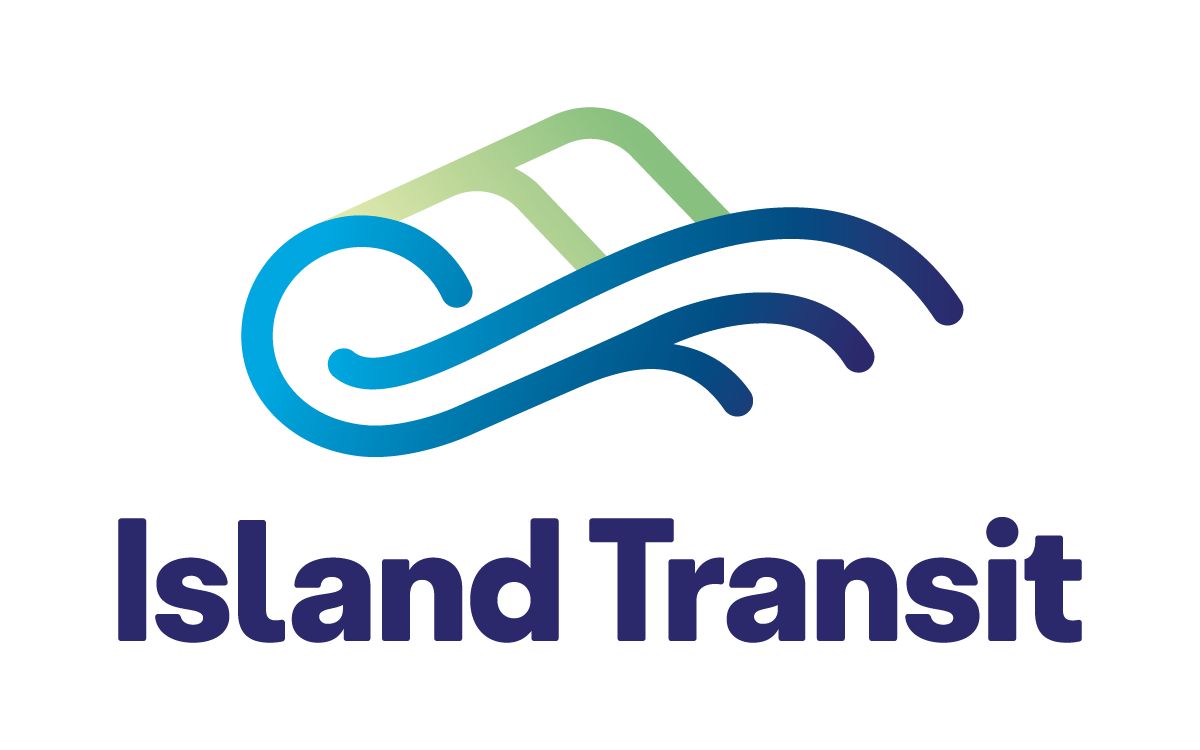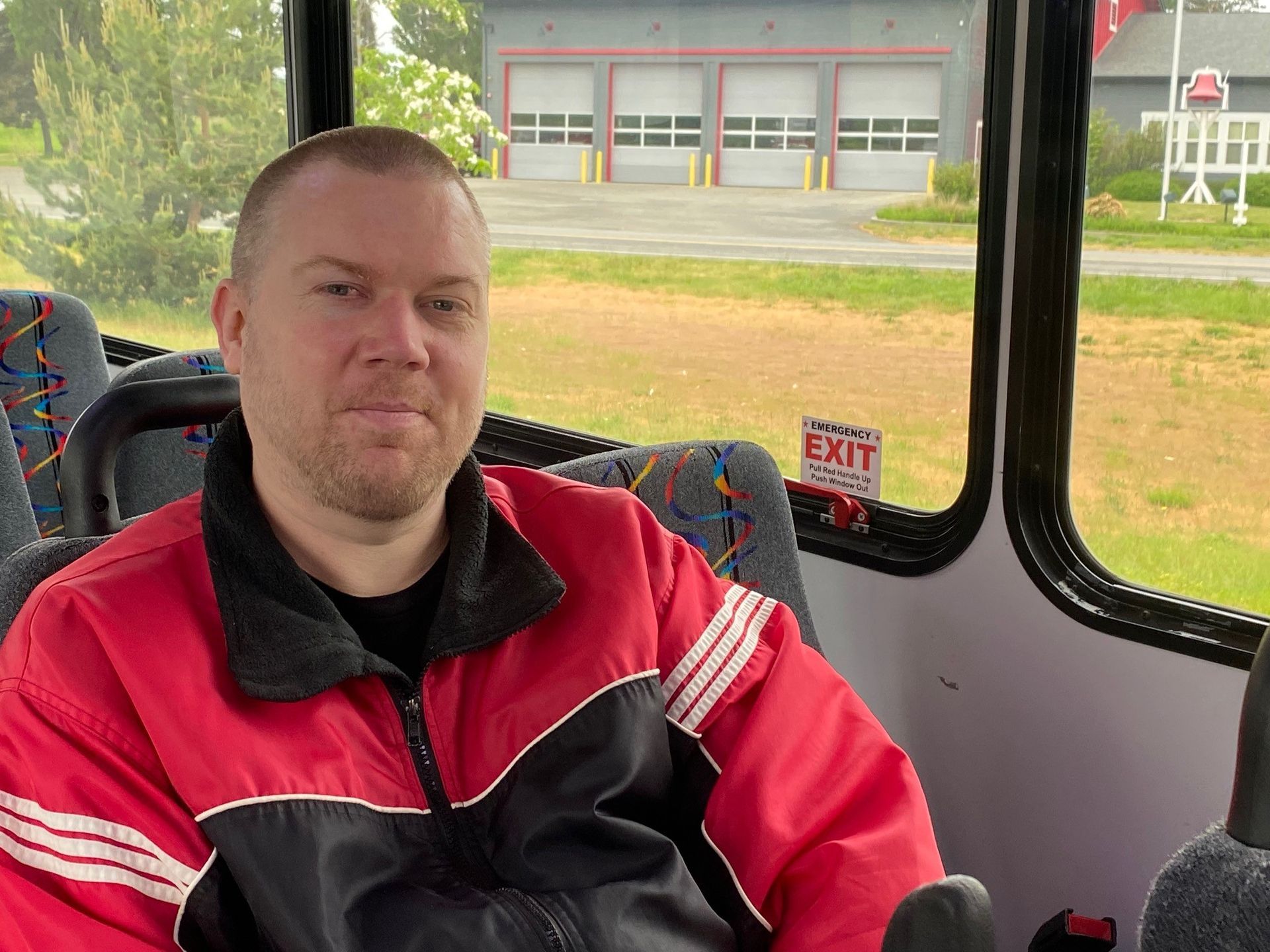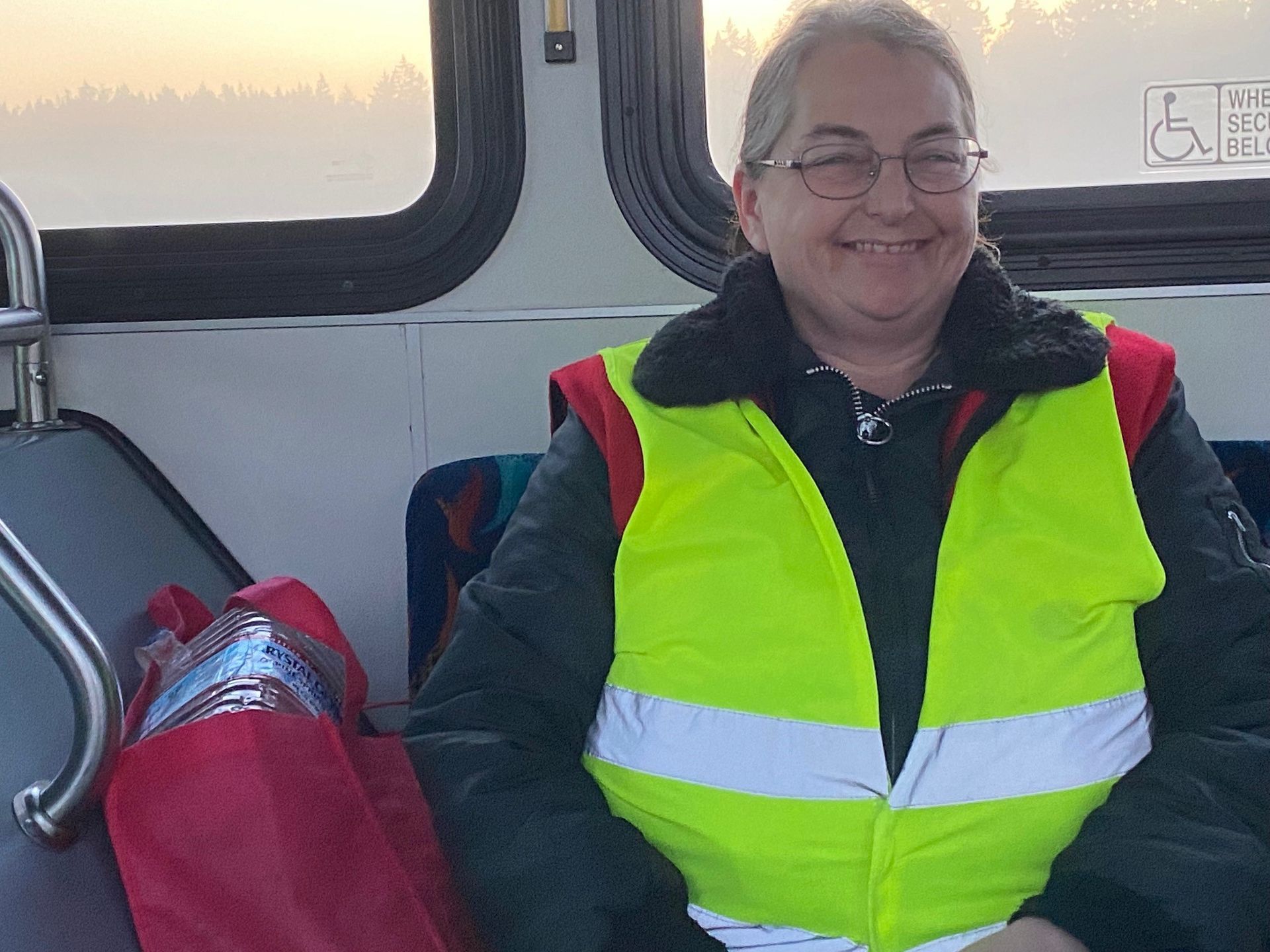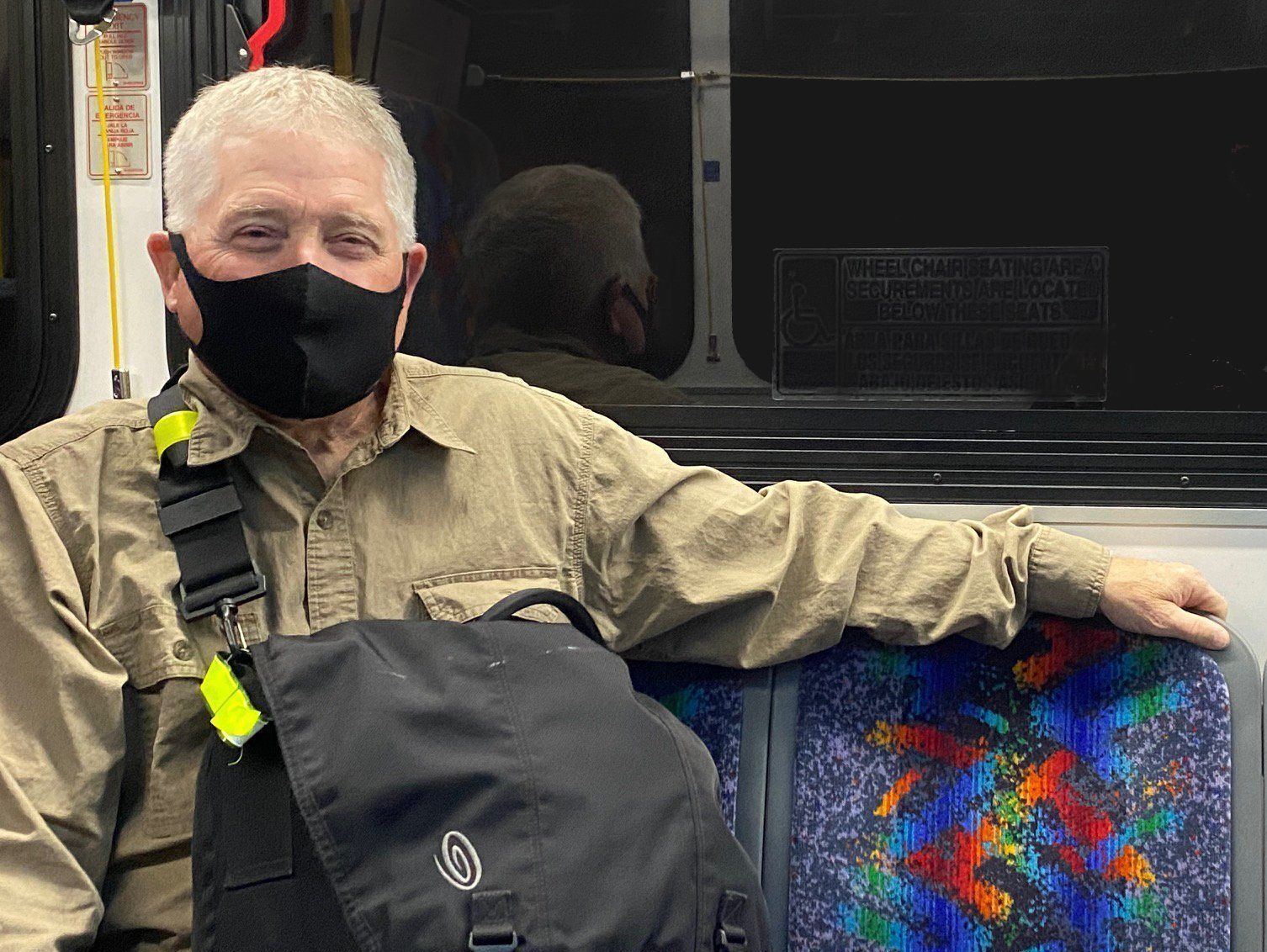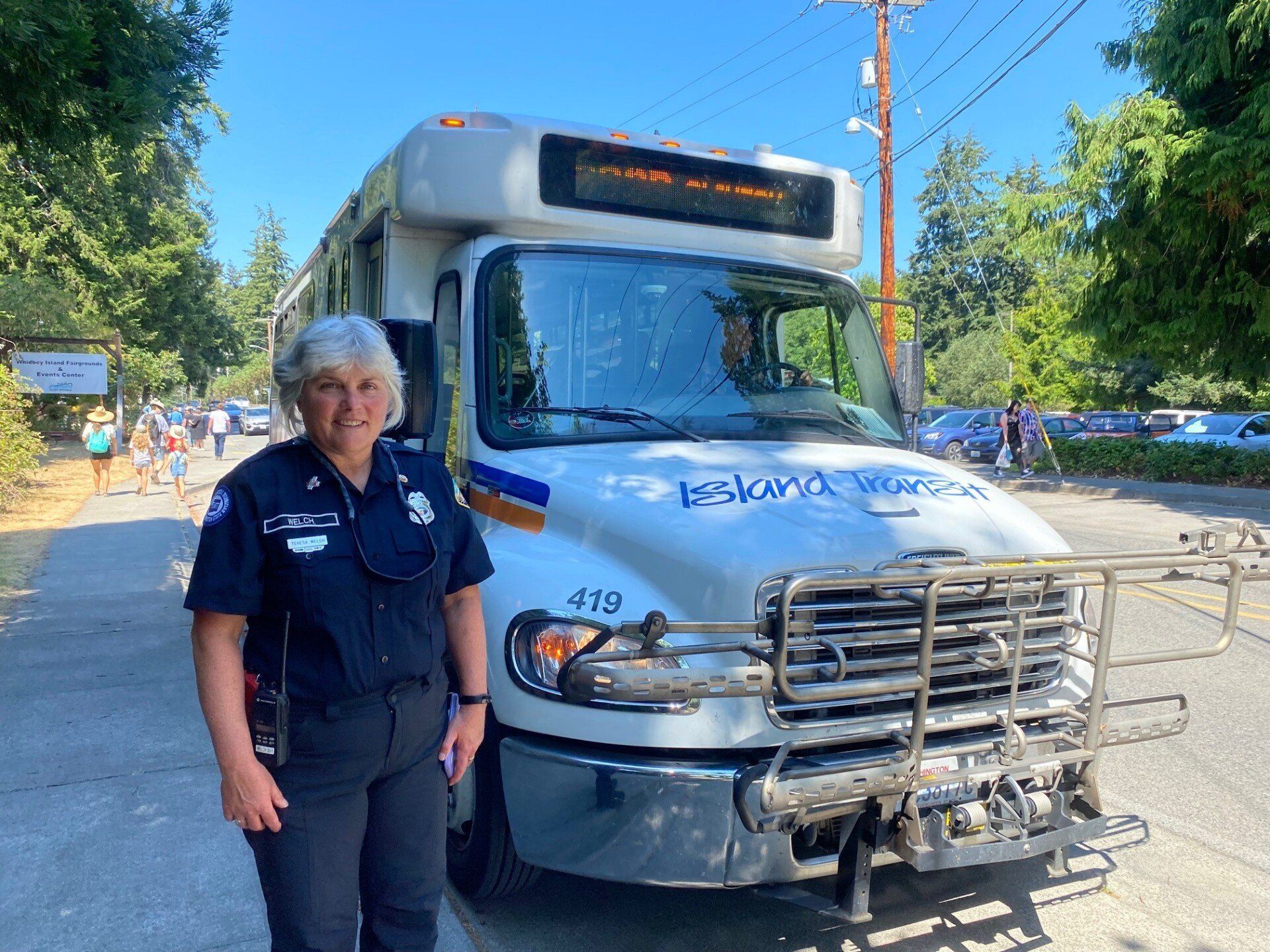> WHY I RIDE
-
Sno-Isle Library Manager Commutes to Work, and Advocates for Libraries, Using Island Transit
Meet Bryan, the Sno-Isle’s Clinton Library Manager and recent transplant from Eastern Washington. He and his family moved to Whidbey Island less than a year ago and have settled in nicely to the island way of life. Bryan is a seasoned user of public transportation, so he was excited to learn that Island County has its own public transportation system – Island Transit. “I’m so grateful to have some options to make greener choices for commuting,” he explains. Bryan has now been riding Island Transit to commute to work for over 3 months and has been very impressed with the experience so far, stating, “This transit system is the best I’ve ever used!”
On the days he does commute with Island Transit, Bryan starts his day on the Route 1 bus. The Route 1 bus serves as a lifeline for many residents, connecting them from one end of the island to the other. Taking the bus is a great way to start your day and allows you to do other things during your commute. Bryan says he, “enjoys being able to read a book…” while on his way to work. He also realized that riding the bus has been an incredibly beautiful experience. Watching people connect on the bus through conversation, talking like they’ve known each other for years, really brings to light how much community really matters and the importance of connection.
In addition to sharing his experiences as a rider, Bryan passionately advocates for the Clinton Library, emphasizing the important role the library has in the community. “We play a vital role in our community. Our amazing staff are here for you to discover new resources or materials to align with your interests,” Bryan expressed. The library serves as a hub for various resources including free internet access, social service information, and a welcoming space for residents. Bryan encouraged Island Transit to consider including stops as close as possible to libraries on the islands, reinforcing the symbiotic relations between transit services and community agencies.
As Island Transit continues to evolve, Bryan’s insights serve as valuable input for future route considerations. It is important to highlight the collaboration between transit agencies and community institutions, reinforcing the idea that a well-connected transit system contributes not only to efficient commuting but also to the overall well-being of the Island County community. Island Transit remains committed to providing excellent service and looks forward to continued collaboration with community partners, and folks like Bryan, for a more connected and accessible Island County.

-
Island Transit Rebranding Event: Celebrating Passion and Community Connection
The Island Transit rebranding event was more than just a celebration of a new look and feel; it was a testament to the community spirit and the power of public transportation to bring people together. Among the attendees were three young transit enthusiasts who traveled exclusively by public transportation to join the festivities. Their stories highlight the backgrounds and shared passion that make the transit community unique and vibrant.
Parker:
Parker, a 20-year-old from California who grew up in Washington, has been fascinated by trains and buses for as long as he can remember. His interests in roads and infrastructure were only heightened during the COVID-19 pandemic when he began walking extensively and noticing the challenges faced by pedestrians, bikers, and public transit users. Parker’s dedication to public transportation is evident in his frequent use of King County Metro and Pierce Transit, averaging five trips per week.
Hearing about the Island Transit rebranding event from fellow enthusiasts, Parker was determined to attend. His journey was a testament to his commitment starting with a King County Metro bus, transferring to Sound Transit’s light rail, then a Community Transit bus to Mukilteo, followed by a ferry to Clinton, and finally the Route 1 Northbound Island Transit bus to the Island Transit facility in Coupeville. Parker praised Island Transit for its community outreach and fare-free service, aspects that make it one of his favorite transit agencies. As a member of the Pierce Transit Citizen Advisory group and an active Instagram user, Parker continues to advocate for improved infrastructure and public transportation accessibility.
Nathan:
Nathan, also 20 and from Lynwood, WA has been captivated by vehicles, trains, ferries and buses since childhood. Currently studying diesel mechanics, Nathan’s connection to public transportation began in high school when he relied on it daily. Now, he takes public transportation whenever he can, especially for significant events like the Island Transit rebranding.
Nathan’s journey to the event involved taking a Community Transit bus to Mukilteo, followed by a ferry to Clinton and then the Route 1 Northbound Island Transit bus. His anticipation was high, eager to see the new livery and reconnect with the agency that provided his first bus experience in Langley. Nathan’s enthusiasm extends beyond riding buses; he created a Discord server in 2021 to foster conversations and connections among transit fans, which now boasts about 200 members. Nathan shares his transit adventures and encourages others to explore public transportation.
Zack:
At 22, Zack from Bremerton, WA has always had a knack for numbers and trip planning. As a senior in college studying business administration and communications, Zack appreciates the environmental benefits of public transportation and the community it creates. Using Kitsap Transit 3-4 times a week, Zack heard about the Island Transit rebranding event through Instagram and his friends Parker and Nathan on the Discord server they met through.
Zack was thrilled to see the new livery and design of Island Transit’s rebrand. For Zack, the highlight was walking through the maintenance building, engaging with Island Transit employees, and connecting with fellow transit enthusiasts. His social media captures his transit experiences and the friendships formed through shared interests.
The Island Transit rebranding event was a resounding success, not just for its unveiling of new designs but for the community connections it fostered. Parker, Nathan and Zack exemplify the passion and dedication for the transit community, highlighting the essential role public transportation in connection and inspiring future advocates.
Check out the Instagram accounts of Parker, Nathan and Zack to get inspired: Parker (@buffered_bike_lane), Nathan (@pnwtransit) and Zack (@zackary.shoemaker)
-
Island Transit Offers Riders Flexible, Convenient, and Fare Free Rides
Garrin is a Stanwood resident and enjoys frequent visits to friends on Camano. On his way back home, he makes a stop at the Food Bank. Dealing with a gradually worsening physical disability throughout his life, Garrin has learned to adapt, saying, "You learn what works and adapt to the changes." Since he cannot drive, he relies on the bus for transportation and, for the past six years, has been using Island Transit, which he prefers over Community Transit in Stanwood because it's free and more frequent.
“I like Island Transit better, it’s free.” You don’t have to worry about bus passes or getting the correct change. “And it runs more frequently.”
Even though he's a fan of Island Transit, Garrin offers suggestions for improving the transit station at Terry’s Corner. Currently, buses display a small sign in the window by the door indicating their route. Garrin suggests having a post or sign at the station that designates where each bus will park for its route. This would provide passengers, especially those with mobility challenges like himself, with advance knowledge of where to wait for their bus, allowing them more time to prepare to board.
While Garrin doesn't currently require a wheelchair, he acknowledges that he might in the future. Learning how to use the bus system becomes crucial in such scenarios. Fortunately, Monty, his favorite bus operator and the current bus operator of the year, along with other drivers, can provide assistance and guidance on using the bus, ensuring a smoother experience for passengers with mobility challenges.
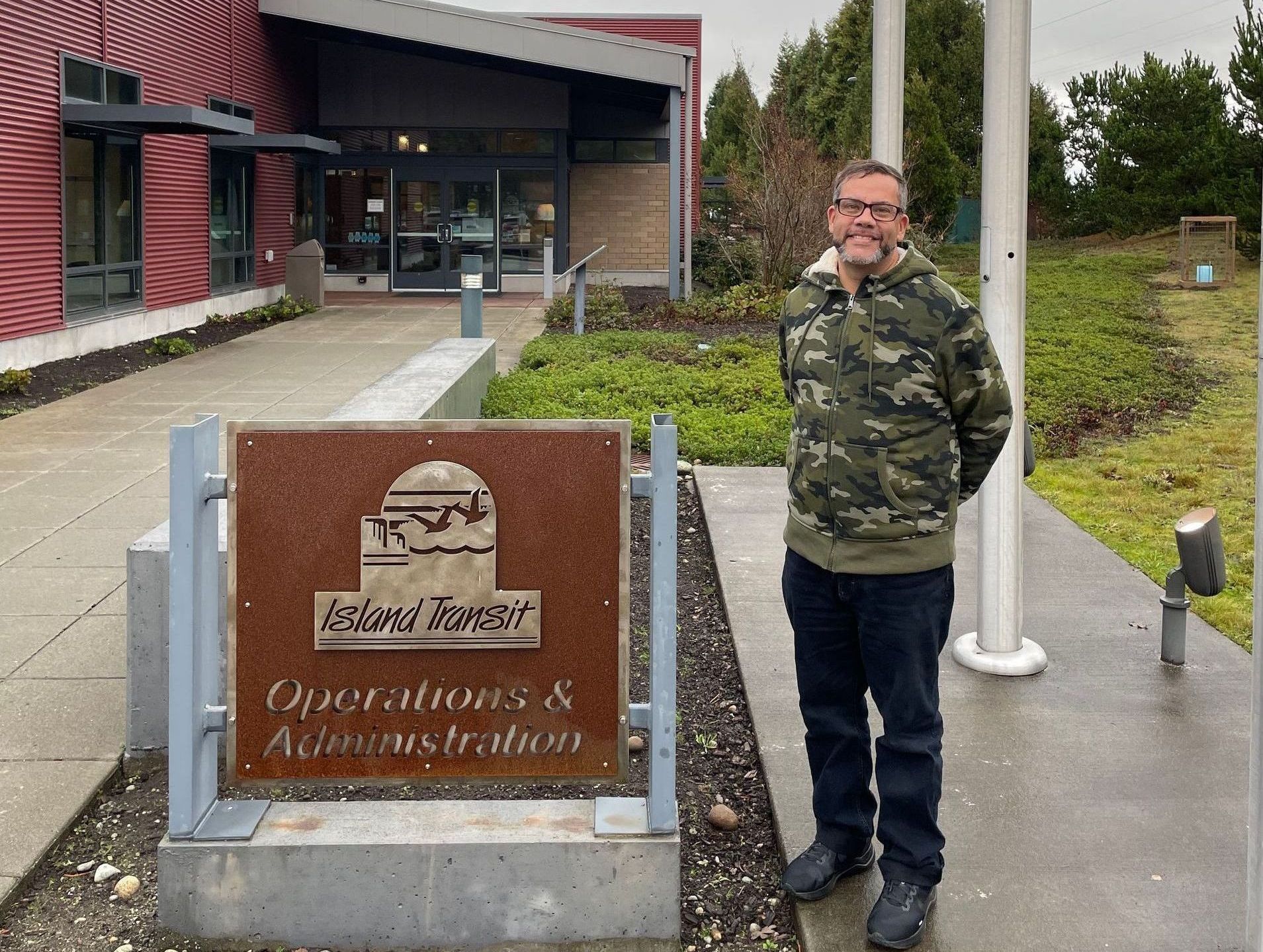
-
Bridging the Gap – Journey from Veteran to Advocate on Whidbey Island, Empowered by Island Transit.
Meet James, a veteran from San Diego and an advocate for the Vets to Peers program. Through the Military Space Available Program, which allows military personnel to travel on military aircraft if there is space available, James landed on NAS Whidbey and discovered not only a serene location but also a mission to assist the connection between fellow veterans and essential resources.
James was struck by the tight-knit community and the unique challenges faced by veterans in the area. “I am trying to help veterans get the resources they need… it’s important work,” he explains. Having served his country, James feels a profound sense of duty to give back to those who have also sacrificed for their country. With a desire to facilitate connections and improve the quality of life for fellow veterans, James wants to bridge the gap between the veteran community and essential resources, with Island Transit emerging as a key link in his mission.
Island Transit became a vital pillar in James’ efforts, recognizing that reliable transportation is often a significant hurdle for veterans, especially those without personal vehicles. James wants to educate veterans about the various routes and services offered by Island Transit, emphasizing how it could empower them to engage more fully in their community. One of the aspects that James highlights is the accessibility of Island Transit's services, making it easier for veterans to access healthcare facilities, employment opportunities, and other essential resources. Island Transit's commitment to providing an inclusive and accessible transportation network aligns seamlessly with James's vision of enhancing the overall well-being of veterans in Island County.
James' personal experience demonstrates the transformative impact of Island Transit. As he shares his story, he emphasizes how our bus services have enabled him to get around the island fare free, get to meetings, and connect with local veterans' organizations. “[Island Transit] gives people like me, a Vet, a chance to get to where I need to go and help others. Without Island Transit, I couldn’t do what I do,” James explains. The sense of independence and freedom afforded by Island Transit has allowed James to pursue his goals and contribute meaningful value to the Island County community. As James continues his mission to support veterans, Island Transit remains a crucial pillar in his endeavors.
James' journey symbolizes the spirit of community service and resilience that defines the veteran experience. Through his efforts to connect veterans with essential resources using Island Transit, James showcases the power of collaboration and the transformative potential of accessible public transportation. As Island Transit continues to play a central role in supporting veterans' integration into the community, it stands as a model for how public services can contribute to the well-being of those who have sacrificed for their country.
If you are a veteran in need of assistance, we have provided the name and contact information of some local agencies that can help you:
Growing Veterans (360) 553-3577, Whidbey Veteran Resource Center (360) 331-8081, Island County Veterans Assistance (360) 632-2496”
-
30 Year Bus Veteran Holds Current Title for Longest Dedicated Bus Rider
“It’s a joy to ride but I know joy-riding is not allowed.” Spoken like a veteran bus rider. Riding non-stop all day is not allowed. But this is different.
Alexandria first saw the bus at 17 and said to herself, “I need to do that.” She jokes that it was Island Transit’s second day of service, over 30 years ago. She’s been using the bus ever since.
Alexandria lives near the southern-most point of Whidbey Island at Scatchet Head. The bus comes to her neighborhood at 5:17 and 5:57 in the morning to take commuters to the ferry. It doesn’t come back until 5:40 at night.
Alexandria works in Langley which is still fast asleep at 6 a.m. She doesn’t start work until 9:30. So she catches the Route 58 bus from Scatchet Head to the ferry. Then she switches to the Route 1 and rides to Oak Harbor and back. “I don’t mind. I like riding the bus.” She talks with the driver and other passengers. She’s made a lot of friends on her morning rides.
In Oak Harbor, she gets off at Harbor Station and walks to Smith Park. Or she walks the waterfront trail back to Walmart to catch the next bus south. Or, if it’s cold and wet, she walks around inside Walmart or Safeway. Sometimes she’ll get a bite to eat at Wendy’s. Occasionally, she gets off and walks around Coupeville. Even though most of the businesses are closed, she loves Coupeville and enjoys window shopping. Sometimes she gets a cup of cocoa at the Tyee or does some shopping at Prairie Center.
She meets people on her walks to the bus before and after work. She’s taught people how to use the bus and carries extra bus schedules to share. Once in 2020, there were three boys in Langley who asked her, “Do you know where we can find some masks?” She pointed to the bus shelter on Anthes Street and said a bus would arrive in two minutes. “There are free masks on the bus. You could ask the driver for some.”
Once, for the heck of it, she went from Scatchet Head to Camano and back in a day. She made her plan and called Island Transit to make sure it was feasible. They checked and said, yes. She took 11 buses with a scenic trip around the west side of Camano looking back at Whidbey. “It was a fun day.”
In her many years using transit she has seen changes in bus service. “We used to get more service at Scatchet Head.” She has kept abreast of the proposed future changes and looks forward to On-Demand service to her neighborhood. It’s being tested in the area northeast of Oak Harbor now and may soon expand to the south end. “Then you can find out exactly where and when people need the bus and adjust your schedule accordingly.” Until then, Alexandria will enjoy the ride, but no, she’s not

-
A man, His Daughter, and Their Island Transit Adventure
Bob and his daughter Brittany met at the Seattle airport and began a week-long adventure using only public transit exploring Whidbey, Port Townsend, and San Juan Island. Bob says he enjoys figuring out the transit schedules and planning adventures. “My wife and I have used public transit throughout Europe and Great Britain, as well as Hong Kong and major cities in the USA. But we have never done anything like this before. Island Transit exceeded our expectations.” Here is the log of their journey.
Day 1, October 11, Tuesday: I departed from home for a 90-mile drive to Las Vegas. After parking at a Park & Ride lot, I took a city bus to the airport, and boarded a flight to SeaTac. Brittany’s husband drove her to the OKC airport where she departed on a flight to Seattle.
We arrived at SeaTac within an hour of one another and found our way to the light rail. We rode the train and two buses to the Mukilteo Ferry. After getting off the ferry at Clinton, we boarded an Island Transit Route 1 bus for a 65-minute ride to Oak Harbor and the Acorn Motor Inn where we stayed for 6 nights. Along the way, a very personable bus driver served as our tour guide, suggesting things to do, and places to eat. Even though it was not a bus stop, she dropped us off at our hotel. An hour later, we enjoyed a delicious seafood dinner at Seabolt’s Smokehouse where I feasted on the local Penn Cove mussels, and Brittany indulged with Salmon.
Day 2, October 12, Wednesday: After a 10-minute walk to Harbor Station, we boarded Island Transit Route 411 and departed for a 35-minute ride to March’s Point where we connected to Skagit Transit Route 410 and a 20-minute ride to the Anacortes Ferry. The roundtrip ferry fare was well worth the scenic ferryboat ride to Friday Harbor, where we walked around town and the marina for about two hours. Being October, many of the businesses were closed in Friday Harbor, and there was no public transit after September 30, so we headed back to Anacortes. Back at the ferry terminal, we boarded a Skagit Transit bus to Anacortes and had lunch at Island Café. From there we walked along the marina through Rotary Park, and along the waterfront to Oren Gazebo. From Oren Gazebo, we climbed seemingly straight up the hill to the peak at Cap Sante Park. The views were well worth the climb. It was a much easier trip back to the marina walking the well-maintained trails. We took the Skagit Transit 410 bus back to March’s Point, connecting to Island Transit Route 411W back to Harbor Station.
Day 3, October 13, Thursday: Haggen Grocery is directly across from the Acorn Motor Inn and was a place we visited daily for fresh fruit and other food supplies for our journeys. Next door to Haggen, on South Barrington is a conveniently located Transit stop for our journeys south of Oak Harbor. Day 3 began at that transit stop where we boarded the Whidbey Route 1 bus for South Whidbey State Park.
On the bus, we were treated to new bright yellow vests from Maribeth Crandell of Island Transit. We received advice for what to expect at the state park from a very nice lady sitting in front of us, as well as Maribeth who assured us it was not too strenuous for Brittany (40) and me (71). South Whidbey State Park was very quiet with seemingly no other hikers, but we were not disappointed. We explored the park on one side of the road and arrived back to the Transit stop. I realized that I had misread the bus time. So, we had 40 minutes to hike on other side of the highway before boarding the bus to Bayview Park and Ride where we transferred without incident to Route 60 to the quaint little town of Langley.
We walked the town, Seawall Park, the marina, and had lunch in the park from the Star Store’s deli. We had a nice short transit ride back to Bayview P&R, where we connected to the Whidbey Route 1 bus to Coupeville. We walked the town of Coupeville and the wharf, then boarded a bus to Oak Harbor. The Route 6 bus took a different route than what we had been on before, along Madrona Way. We asked about the platforms in the bay, and the driver explained that it was where the Penn Cove mussels are harvested.
Day 4, October 14, Friday: We boarded the Whidbey Route 6 bus for the 33-minute ride to the Coupeville-Port Townsend ferry which took us to Port Townsend. We walked Port Townsend, up and down and along the waterfront, stopping to tour the historic post office and the Palace Hotel. We had lunch outdoors by the water at the Soda Fountain and Diner and returned by ferry to Fort Casey for the afternoon. Then we took the Whidbey Route 6 for the 50-minute ride back to our motel. That evening we feasted at the DH (Chinese) Buffet in Oak Harbor.
Day 5, October 15, Saturday: Again, we walked to Harbor Station where we boarded the bus for Route 411W to Deception Pass. The driver pointed out the spot he would pick us up on the return before he let us off at Deception Pass at Seabolt’s store. From there, it was a long hike up to the Goose Rock Summit, the highest point in the park, and then down to the bridge. We walked both bridges, stopping to hike Pass Island. On the north side of the bridges, we hiked down to the water following the signs to Lighthouse Point, only to find that there was no lighthouse. Regardless, the trail and views were outstanding. We hiked back up and over the bridges and spent the rest of the day exploring the south side of the park. In all, we spent 7 hours on Saturday at the Deception Pass State Park before boarding the Island Transit bus back to Harbor Station. I for one, was worn out.
Day 6, October 16, Sunday: Sunday is apparently a day of rest for Island Transit, so Brittany attended church services while I hiked around town. After church we had lunch again at DH Buffet, before spending the remainder of the day hiking around Oak Harbor and discovering the waterfront parks.
Day 7, October 17, Monday: We hiked the remainder of the Oak Harbor waterfront trails before boarding the Island Transit Route 1 bus for the trip back to the Mukilteo Ferry, and then two more buses, and the light rail back to SeaTac Airport to catch our flights.
Brittany and I really enjoyed our adventure. We would highly recommend the Acorn Motor Inn for its value, cleanliness, hospitality, comfortable beds, and an unbeatable location. The location was great for groceries, restaurants, waterfront, and especially the proximity to Island Transit. Oak Harbor served as an ideal hub for our daily explorations.
Island transit was the key to it all, with its free transportation all over Whidbey Island. The drivers were especially friendly and helpful, and on time. I wish I had made note of the driver’s names, but to single any driver out would be a disservice to all the rest who pleasantly preformed their jobs. The buses were always clean and comfortable. In all, we had 14 rides on Island Transit, and met numerous friendly riders along the way.
Sincerely, Bob from Nevada
Any endorsement of a particular establishment does not constitute an endorsement by Island Transit. These statements are the opinions of the author.
-
Three Decades of Riding Island Transit … and Counting
Doug started riding Island Transit in 1989, thirty-three years ago. He lived in Clinton then and caught the bus from the ferry to his job in Coupeville. Years later he moved to Langley and caught the small bus transferring to the Route 1 at the Bayview Park and Ride. It took a little more time, but it was still better than driving all that way. Now he lives near Greenbank so his commute is shorter. He used to be able to catch the bus from his house, but when the bus routes changed, he started driving to downtown Greenbank, parking by the Progressive Hall, and catching the bus across from the store. “You have to be flexible when routes change.” He has adapted well to all these changes through the years and remains a consistent bus rider. I asked him why. He said, “It’s a good alternative to paying for gas. I hate the oil companies!” After three decades of taking a fare-free bus, he has saved a lot of gas, money and reduced his carbon footprint considerably.
Doug began taking a bus when he was in college at the UW and took it all around King County. When he moved to Whidbey and began working for Island County, he continued his transit habit. “I’ve always had good experiences on Island Transit. I’m almost always on time and hardly ever late.” He remembers other bus commuters who have retired or moved on, but he is not one who normally socializes on the bus. Doug is a voracious reader. He carries a shoulder bag that pops open as soon as he takes his seat and out comes a book. As the bus approaches his stop, the book goes into the bag. Doug zips it shut, swings it over his shoulder and is ready to step off as the bus comes to a stop.
Over thirty-three years Doug has seen a lot of changes with Island Transit, like the new hybrid buses. He sees changes in bus riders, too, and realizes that there are those in our community who cannot drive. He has empathy for the homeless, low income and those with mental health issues or disabilities that ride the bus. Recently, he saw someone suffer an epileptic attack on the bus. The driver had to pull over and call for assistance to help the person. He’s seen people spill a whole cup of coffee, make other messes or the bus may have a mechanical problem that required a switch in buses at the next opportunity. Still, he is content with his commute, saving gas, money, the planet, and a few of his fellow community members all at once. And he cannot begin to count the number of books he’s enjoyed in route.
-
Taking Public Transit Saves Money, Time, and the Planet – One Less Carbon Footprint at a Time.
Terry has an adventurous spirit. She taught school in Colombia for two years before coming to teach Science at the Coupeville Middle School in 1996. Terry started commuting by bus from the get go. "The bus is very convenient, reliable, and free". She said she has saved a lot of gas money over the years and reduced her carbon footprint. “When I drove my car, I would always end up staying late. The bus would help me leave at a reasonable time after school. I commuted by bus about 90% of the school year.” She recently retired but still takes the bus when she substitutes for the school district.
Terry is an avid cyclist and has often put her bike on the bus so she can go for a ride after work. She used to meet other bus and bike commuters for a friendly twenty-mile ride. They would all be wearing their bright green and gold colors for visibility.
In twenty-six years of riding Island Transit she has gotten to know the other bus commuters and the drivers. She has taught some of their kids and has become friends on and off the bus. Terry is also a Soroptimist, aids seniors, and is a volunteer fire fighter - so it would be understandable if she nodded off on the bus to work. But she keeps busy, checking emails, studying papers, reading the news, making good use of every spare minute.
As a teacher, Terry was known for her adventurous field trips. She has taken groups of students to Thailand, the Amazon, and Iceland as well as more local adventures by both land and by sea. She encourages her students to use the bus and has incorporated the bus as part of her field trips. The class would go to South Whidbey State Park or Fort Casey by bus – plus reducing their carbon footprint by taking the bus fit into her science curriculum.
Besides her adventures on Whidbey, Terry took public transit while teaching in Columbia, from Whidbey to SeaTac, and to the University of Washington for teacher training. In comparison to other transit systems, she says Island Transit is much cleaner and the drivers have always been really nice and helpful. Once when it snowed and her bus had to stop five miles from her house, an Island Transit Road Support van came and gave her a lift home. “They go out of their way for their riders.”
